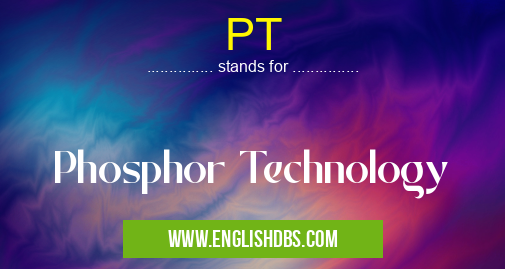What does PT mean in TECHNOLOGY
PT, also known as Phosphor Technology, refers to the use of phosphors to enhance the performance of electronic devices. Phosphors are materials that emit light when exposed to energy sources like electricity or ultraviolet radiation.

PT meaning in Technology in Computing
PT mostly used in an acronym Technology in Category Computing that means Phosphor Technology
Shorthand: PT,
Full Form: Phosphor Technology
For more information of "Phosphor Technology", see the section below.
» Computing » Technology
What is PT (Phosphor Technology)?
PT utilizes phosphors to improve the efficiency, brightness, and color accuracy of various electronic displays and lighting applications. It plays a crucial role in enhancing the visual experience in devices such as:
- Televisions: Phosphor coatings on the inner surface of CRT screens convert electron beams into visible light, providing vibrant and detailed images.
- Computer monitors: Phosphors in liquid crystal displays (LCDs) enhance the brightness and color gamut, delivering sharp and realistic visuals.
- LED lighting: Phosphor layers convert the blue light emitted by LEDs into different wavelengths, enabling a wider range of colors and improved efficiency.
How does PT Work?
Phosphors are typically composed of inorganic compounds, such as zinc sulfide or yttrium aluminum garnet. When phosphors are excited by an energy source, their electrons absorb energy and jump to higher energy levels. As the electrons return to their original state, they release the absorbed energy in the form of light.
Advantages of PT
PT offers several advantages:
- Enhanced brightness: Phosphors can intensify the emitted light, improving the overall brightness of displays.
- Improved color accuracy: Phosphors allow for precise color reproduction, resulting in more realistic and vibrant visuals.
- Increased efficiency: Phosphor technology can enhance the efficiency of light generation, reducing energy consumption.
- Durability: Phosphors are generally durable and can withstand prolonged use, ensuring consistent performance over time.
Essential Questions and Answers on Phosphor Technology in "COMPUTING»TECHNOLOGY"
What is Phosphor Technology (PT)?
Phosphor Technology (PT) utilizes phosphors, materials that emit light when exposed to specific forms of energy such as electricity or ultraviolet radiation. These phosphors convert electrical or UV energy into visible light, making them essential components in various lighting applications.
How does PT work?
PT utilizes phosphors, which absorb energy from an excitation source, such as an electric current or UV light. The absorbed energy excites electrons within the phosphor, causing them to jump to higher energy levels. As the electrons return to their original state, they release the absorbed energy in the form of visible light. The specific color of light emitted depends on the type of phosphor used.
What are the advantages of PT?
PT offers various advantages, including:
- High efficiency: Phosphors convert energy into light efficiently, minimizing energy loss and improving overall lighting performance.
- Tunable color temperature: Different phosphors can produce various color temperatures, allowing for customization of lighting to meet specific requirements.
- Long lifespan: Phosphors have a long lifespan, ensuring stable and consistent lighting over extended periods.
- Compact size: Phosphor-based lighting systems can be compact, making them suitable for space-constrained environments.
What are the applications of PT?
PT finds applications in a wide range of lighting fields, including:
- Solid-state lighting (SSL): Phosphors are used in LEDs to convert blue or ultraviolet light into various colors, enabling the production of white light.
- Fluorescent lighting: Phosphors coat the inner surface of fluorescent tubes, converting UV light from the electric discharge into visible light.
- Backlighting: Phosphors are used to create uniform and efficient backlighting in displays, such as LCD screens and televisions.
What are the limitations of PT?
While PT offers numerous advantages, it also has some limitations:
- Thermal sensitivity: Phosphors can be sensitive to heat, and their efficiency may decrease at elevated temperatures.
- Aging: Phosphors can degrade over time, leading to a gradual reduction in light output.
- Environmental concerns: Some phosphors may contain hazardous materials, requiring proper disposal and recycling practices.
Final Words: PT (Phosphor Technology) is a significant advancement in electronics, enabling the development of brighter, more efficient, and color-accurate displays and lighting applications. Its use across various devices has revolutionized the visual experience for users. As technology continues to evolve, we can expect further advancements in PT to enhance our visual experiences even further.
PT also stands for: |
|
| All stands for PT |
